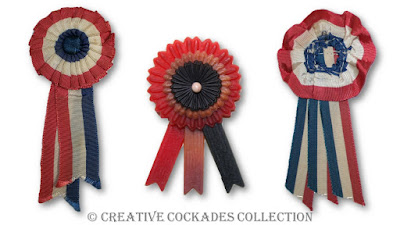THE REVOLUTIONARY WAR & WAR OF 1812
Before the Revolutionary War, American military wore the Hanovarian black cockades of King George of Great Britain. When the colonies seceded from Britain, they continued to wear the black cockades inherited from the mother country.However, for the first few years of the war, General George Washington created a new military cockade style. “As the Continental Army has unfortunately no uniforms, and consequently many inconveniences must arise from not being able to distinguish the commissioned officers from the privates, it is desired that some badge of distinction be immediately provided; for instance that the field officers may have red or pink colored cockades in their hats, the captains yellow or buff, and the subalterns green. July 23, 1775”
In 1780, the military cockade system was changed again. France had entered the war against Britain in 1778 and France’s cockade was white. Thus, as a symbol of the two nations’ alliance, George Washington established that the American cockade would be an Alliance Cockade – black with a white center. Many of the French troops likewise wore an Alliance Cockade of white with a black center.
After the war, the American military cockade was standardized once and for all. “All persons belonging to the army, to wear a black cockade, with a Small white Eagle in the centre. The cockade of non-commissioned officers, musicians and privates, to be of leather, with Eagles of tin. James McHenry, January 9, 1799.”
THE CIVIL WAR 1860-1865
Civil War cockades were usually handmade by the ladies, though occasionally they were offered by manufacturers and merchants. They were often created out of silk ribbon, but there is documentation for cockades made of cotton and wool as well.Most pro-Unionists cockades were red, white and blue. And the most popular colors for pro-Secessionists were solid blue, solid red, or red and white.
The Charleston Mercury described the Secession cockade: “The badge adopted is a blue rosette, two and a half inches in diameter, with a military button in the centre, to be worn upon the side of the hat… The blue cockade was worn by almost everyone, even the ladies and children joining in showing their devotion to the Palmetto State.” A letter from Mississippi observed, “Not content with wearing the blue cockade themselves, the people put them upon wagons, carriages, riding horses, etc.”
When secession was declared in South Carolina, the reverberations – and cockades – could be seen even in Washington DC. “The shouts were those of rejoicing over a telegram announcing the secession of South Carolina. …. It was the late dinner hour, and dining-rooms and corridors were shaken with excitement, as men with the blue cockades of the secessionists brushed jubilantly past those who wore the colors of the Union.”
Wearing a cockade could be dangerous. The New York Times observed, “Our informant, though himself an owner of negroes, and an advocate of the institution of Slavery, was twice fired at for wearing a Union cockade.”
In some places, the government actually outlawed cockades. In Baltimore in 1861, the Public Ledger reported, “The Government is determined to put a stop to the Secession cockades and other emblems which have been so unblushingly exhibited in Baltimore for months past and those found wearing them in the future will be arrested as traitors against the Government.”
Cockades could frequently be the cause of personal conflicts as the Richmond Daily Dispatch worried: “Some of our young gentlemen have mounted the blue cockade and the Virginia button, while others sport the red, white and blue rosettes. We hope they will not come in collision during these exciting times.”
Cockades were the outward symbols of the underlying passions of the war. Harper's Magazine declared in 1861, “The passengers in the streets wear badges, rosettes, and cockades of the trinity of patriotic colors. In shawls, in cravats, in ribbons, the same tricolor appears. . . You feel something in men's motions; you see something in the general manner of the throng in the street before you read it recorded upon the board or in the paper. There is but one thought and one question. The people are soldiers. The country is a camp. It is war.”














Spanish American War
Cockades in the 1890s were often quite glamorous, including gilt stars, tassels, printed streamers, celluloid buttons, and more. Patriotic cockades could simply be red, white and blue or they could include pictures of war heroes.In addition to American cockades, soldiers who fought in the war often wore and brought home Spanish Colonial cockades as patriotic souvenirs.



